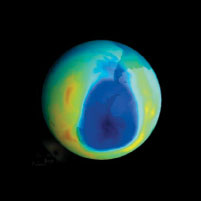The ozone hole may disappear soon
The ozone hole over the Antarctic is likely to begin contracting in the future and might disappear by 2050 because of a reduction in the release of chlorofluorocarbons and other ozone-depleting gases, according to a team of Japanese scientists.

That would be a good thing. Ozone in the upper atmosphere shields the planet from excess radiation. The hole, monitored by satellites and ground stations since its discovery in the 1980s. is an area of depleted ozone, thought to have been created by chlorofluorocarbons released into the atmosphere.
Chlorofluorocarbon levels in the Earth's atmosphere have been declining since the mid-1990s due to international efforts to reduce emissions.
The new findings are based on a series of numerical simulations carried out by Eiji Akiyoshi of the National Institute for Environmental Studies, near Tokyo, using projected emissions of chlorofluorocarbons and other gases blamed for the ozone hole, according to Livescience.com.
The findings are based on a series of numerical simulations carried out by Eiji Akiyoshi of the National Institute for Environmental Studies, near Tokyo, using projected emissions of chlorofluorocarbons and other gases blamed for the ozone hole.
Some scientists, however, have suggested the hole won’t heal until much later because old refrigerators and air-conditioning systems - many in the United States and Canada - are still releasing ozone-killing chemicals. Both countries curbed those chemicals in newer products MSNBC reports.
Satellites and ground stations have been monitoring the ozone hole over the South Pole since its discovery in the 1980s.
Chlorofluorocarbon levels in the earth's atmosphere have been declining since the mid-1990s due to international efforts to reduce emissions, according to the AP.
Source: Agencies
I.L.
Subscribe to Pravda.Ru Telegram channel, Facebook, RSS!


